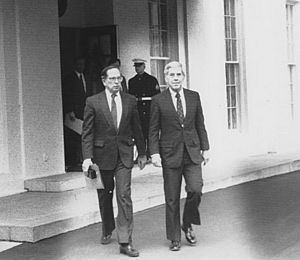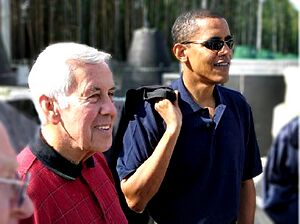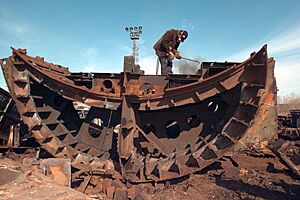Nunn–Lugar Cooperative Threat Reduction facts for kids
The Cooperative Threat Reduction (CTR) program, also known as the Nunn–Lugar Act, was created to help make the world safer from dangerous weapons. It was started by two U.S. Senators, Sam Nunn and Richard Lugar, in 1991. At that time, the Soviet Union was breaking apart. The United States and its allies were worried that nuclear weapons in the former Soviet countries might fall into the wrong hands.
The main goal of the CTR program was to find, secure, and get rid of weapons of mass destruction (WMD). These include nuclear, biological, and chemical weapons. The program also aimed to destroy the places where these weapons were made or stored. Since 1997, the Defense Threat Reduction Agency (DTRA) has managed the money for this important program.
Contents
How the Program Worked (First 15 Years)
The CTR program gave money and expert help to countries that used to be part of the Soviet Union. These included Russia, Ukraine, Georgia, and Kazakhstan. The goal was to help them safely get rid of their huge stockpiles of nuclear, biological, and chemical weapons. This was part of agreements like SALT I to reduce weapons.
The program provided about $400 million each year for four years. This money helped destroy missiles and their launch sites after nuclear warheads were removed. The warheads themselves were sent to Russia to be taken apart. The special uranium inside them was then turned into fuel for power plants, which the U.S. bought.
Over time, the CTR program also started focusing on stopping WMDs from moving around. This included improving security at land and sea borders in these countries.
In 2007, the CTR program had four main goals:
- To take apart and destroy WMDs and their related facilities in former Soviet countries.
- To gather and secure WMDs, their technology, and materials.
- To make things more open and encourage better safety rules.
- To support cooperation between defense and military groups to prevent weapons from spreading.
These goals were achieved through different projects, such as:
- The Cooperative Biological Engagement Program (CBEP), which helps secure dangerous biological materials.
- The Chemical Weapons Elimination Program.
- Programs to secure nuclear weapons storage sites.
- Programs to eliminate strategic offensive weapons like missiles.
The Nunn-Lugar Act played a big part in reducing the number of nuclear weapons. It helped with transporting, storing, protecting, and destroying weapons. For example, it provided equipment to speed up the destruction of large nuclear missiles.
A major success was helping countries like Ukraine, Belarus, and Kazakhstan become free of Soviet nuclear weapons. The U.S. sent special equipment to Belarus to help safely move and get rid of nuclear weapons there. The program greatly reduced the number of nuclear weapons that had been built up during the Cold War.
Another important help was sending storage containers to Russia for fissionable material (the stuff used in nuclear bombs). The U.S. provided tens of thousands of these containers. It also gave $75 million to help Russia build a new storage facility for plutonium from dismantled warheads. The program wasn't just about removing materials; it also helped ensure safe storage and transport within Russia.
Big Achievements in the 20th Century
Thanks to this program, Ukraine and Kazakhstan are now free of nuclear weapons. By 1997, all major Soviet nuclear weapons were removed from Belarus, Kazakhstan, and Ukraine. This was a huge step for global safety.
Here are some of the weapons and facilities that were deactivated or destroyed:
- 537 ICBMs (long-range missiles)
- 459 missile silos (underground launch sites)
- 128 bombers (planes that carry nuclear bombs)
- 708 nuclear air-to-surface missiles
- 408 submarine missile launchers
- 496 submarine-launched missiles
- 27 nuclear submarines
- 194 nuclear test tunnels
Other important results include:
- 260 tons of dangerous nuclear material were made more secure.
- 60 nuclear warhead storage sites had their security improved.
- 35 percent of Russia's chemical weapons were made more secure.
- 49 former biological weapons factories were changed into peaceful research centers.
- 58,000 former weapons scientists were given jobs in peaceful research through special centers.
One site in Ukraine, Pavlograd, started safely taking apart nuclear missiles without burning their fuel. This prevented harmful chemicals from polluting the environment. The missile factory there was even converted into a space program.
Expanding the Program
Over time, the Nunn-Lugar program expanded beyond the former Soviet Union. In 2003, the U.S. Congress allowed the program to help other countries prevent the spread of WMDs. This expansion, called the Nunn-Lugar Expansion Act, provided up to $50 million for countries like Albania, North Korea, Iraq, and Libya.
Libya's Nuclear Program
In 2003, Libya decided to give up its nuclear weapons program. Nunn-Lugar funding helped safely transport nuclear materials from Libya to the United States.
Albania's Chemical Weapons
Albania had 16 tons of chemical weapons. Through the Nunn-Lugar program, the U.S. provided about $38.5 million in 2004 to help Albania get rid of all its chemical weapons. After only three years, Albania no longer had any chemical weapons of mass destruction.
Pakistan and Security Concerns
After the 9/11 terrorist attacks, there were concerns about Pakistan's nuclear weapons and scientists. In 2011, there was talk of expanding the Nunn-Lugar program to Pakistan. This was due to worries about nuclear arms smuggling and the security of dangerous diseases. Senator Richard Lugar suggested that if Pakistan worked with the CTR program, the U.S. could help prevent outbreaks and improve safety.
The Program in Recent Years

Other programs have been built on the success of CTR, like the Proliferation Security Initiative. This shows how important the original program was.
In 2008, a company called Black & Veatch received a contract to help reduce biological threats in Ukraine. This was a key part of the CTR program, working with Ukraine's health and veterinary ministries.
In 2009, Russia opened a large facility to destroy its chemical weapons reserves. About one-third of the funding for this plant, around $1 billion, came from the CTR program. This helped destroy thousands of tons of dangerous chemical agents like Sarin.
Even though the budget for the CTR program has been cut over the years, the U.S. continues to work with Russia on reducing nuclear arms. Leaders like Barack Obama and Hillary Clinton tried to improve nuclear relations with Russia. Their plan aimed to further reduce the number of nuclear weapons in both countries and worldwide.
In 2013, the U.S. and Russia signed a new agreement to continue their cooperation on threat reduction. This new plan built on the success of the original Nunn-Lugar agreement. Under this new framework, Russia took on the costs for some parts of the program, like destroying ballistic missiles and chemical weapons.
However, political events like Russia's actions in Crimea made it harder for the U.S. and Russia to agree on further arms control. Still, there is a shared concern about stopping nuclear weapons from spreading to other countries or groups.
In 2015, Russia decided it would no longer accept U.S. help in securing stored nuclear materials, stating they would continue the program on their own.
The CTR program also helped with other global threats. In 2014, it provided $4 million to deploy mobile laboratory systems to Sierra Leone to help fight the Ebola outbreak in West Africa.
What's Next for CTR
In 2018, a group of experts from the National Academy of Sciences looked at the future of the CTR program. They found that the "Cooperative" part of CTR, meaning working together, was very important. It helped reduce threats by being open and taking action, which also strengthened relationships between countries.
The committee believed that building lasting partnerships with new and existing countries is key for the program's future. Even after 30 years, the CTR program is still seen as "foundational" for keeping the U.S. safe from weapons of mass destruction.
See also
- The World Institute for Nuclear Security
- Project Sapphire
- MPC&A
- Global Partnership Against the Spread of Weapons and Materials of Mass Destruction
- Russia and weapons of mass destruction




